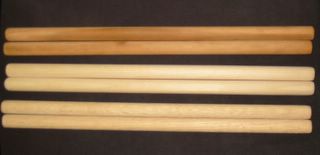
Today I made three pairs of bachi. Bachi are the sticks you use to hit taiko drums, and they come in all kinds of shapes and sizes. The vast majority of bachi are the simple dowels you see above. I needed a pair that were light enough to hit a shime with (shime have more delicate heads, so it's best to use a lighter pair of bachi on them to avoid premature wearing) as well as a josuke, which are the barrel-sized drums that you saw in my previous posts. We're learning another dual-drum song which also includes a lot of bachi flipping. I have a pair of bachi that are fine for hitting both the shime and josuke, but they're tapered, and are hard to flip around because of their uneven weight. There are bachi out there that you can buy that are very light-weight, and are perfect to hit the more responsive shime with, but they're way harder to flip and don't produce the kind of boom I want to get out of a josuke. So today I went to MacBeath Hardwood, our local lumber company (excellent customer service by the way--I think 3 or 4 guys asked if I needed help!), and picked out a few dowels that I thought were both light and heavy enough for the song. They're skinnier than the bachi I normally use, but I was excited to bring them home.
I like my bachi kind of long because I like the kind of fulcrum action you can get out of them. I feel like I can play faster and more economically with slightly longer bachi. I have a pair of bachi that we call "Miyama-style" that are 16 3/4" long, so I decided to make my bachi the same length. Cutting the bachi is one thing, but getting the ends of the bachi to have that nice smooth edge to them is another. You want a smooth tip to protect the head of the drum. I used a dremel that my dad gave to me years ago to help the process along. I've found that homemade bachi have strange angled ends on them--probably because people try to angle a file or something to get the edge tapered out, but they never look even. All of my homemade bachi are like that. But today I figured out how to use the dremel just right to get that professional look. Instead of bringing the dremel or file in to force an angle of the edge of the bachi, just let the dremel follow the grain of the bachi so that it goes from the side to the top of the bachi. It takes a little longer but it's so worth it when it's even and smooth. After that I sanded everything down with some 220 grit. It's best not to sand your bachi too smoothly because you might end up dropping them, or worse, flinging them at teachers/classmates!
Take a look at the tips! Not bad, eh?





No comments:
Post a Comment